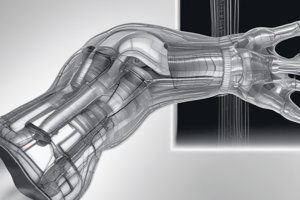Podcast
Questions and Answers
What term includes both computed radiography and direct radiography?
What term includes both computed radiography and direct radiography?
- Radiographic imaging
- Medical imaging
- Computed radiography
- Digital radiography (correct)
What is the primary function of europium in CR imaging plates?
What is the primary function of europium in CR imaging plates?
- To digitize the signal
- To create defects in the barium fluorohalide crystals (correct)
- To absorb radiation
- To emit light
What type of crystals are used in CR imaging plates?
What type of crystals are used in CR imaging plates?
- Barium oxide
- Barium fluorohalide (correct)
- Barium sulfide
- Barium nitrate
What is the purpose of the high-intensity laser beam in the CR reader?
What is the purpose of the high-intensity laser beam in the CR reader?
What is the main difference between CR and DR?
What is the main difference between CR and DR?
When did Fuji introduce the first CR systems in the US?
When did Fuji introduce the first CR systems in the US?
What is the process called when the laser stimulates the movement of trapped electrons back to their original position?
What is the process called when the laser stimulates the movement of trapped electrons back to their original position?
What is the purpose of the fiber optic light guide in CR processing?
What is the purpose of the fiber optic light guide in CR processing?
What happens if the CR plate is not exposed to a bright white light after use?
What happens if the CR plate is not exposed to a bright white light after use?
Why should imaging plates be erased after 48 hours of non-use?
Why should imaging plates be erased after 48 hours of non-use?
What is the consequence of not recognizing the collimated borders during image data analysis?
What is the consequence of not recognizing the collimated borders during image data analysis?
What is the purpose of the Analog-to-Digital Converter (ADC) in CR processing?
What is the purpose of the Analog-to-Digital Converter (ADC) in CR processing?
Flashcards are hidden until you start studying
Study Notes
Imaging Technologies
- Computed Radiography (CR) and Direct Radiography (DR) are both encompassed under the term digital radiography.
Europium in CR Imaging Plates
- Europium plays a crucial role as a activator in CR imaging plates, enhancing their ability to absorb and emit radiation.
Crystal Composition
- The crystals used in CR imaging plates are typically barium fluorohalide crystals, which store energy from X-rays.
Role of High-Intensity Laser Beam
- The high-intensity laser beam in the CR reader is used to stimulate trapped electrons, leading to the release of stored energy as light, which forms the image.
Differences Between CR and DR
- The main difference lies in the detection methods: CR uses a plate to capture images that are later processed, while DR captures images directly with electronic sensors.
Historical Context of CR Systems
- Fuji introduced the first CR systems in the United States in 1983, marking a significant advancement in imaging technology.
Movement of Trapped Electrons
- The process whereby the laser stimulates the movement of trapped electrons back to their original positions is known as photo-stimulation.
Fiber Optic Light Guide Purpose
- The fiber optic light guide in CR processing serves to collect and transmit the light emitted from the imaging plate to the photomultiplier tube for digitization.
Exposure to White Light
- If the CR plate is not exposed to bright white light after use, it may result in persistent luminescence, potentially affecting image quality.
Imaging Plates and Non-Use
- Imaging plates should be erased after 48 hours of non-use to prevent image fading and to maintain optimal performance during subsequent imaging sessions.
Collimated Borders in Image Analysis
- Failing to recognize collimated borders during image data analysis can lead to improper interpretation of the images, which might affect diagnosis.
Role of the Analog-to-Digital Converter (ADC)
- The Analog-to-Digital Converter (ADC) in CR processing is essential for converting the light signal emitted from the imaging plate into digital data that can be processed and displayed.
Studying That Suits You
Use AI to generate personalized quizzes and flashcards to suit your learning preferences.




